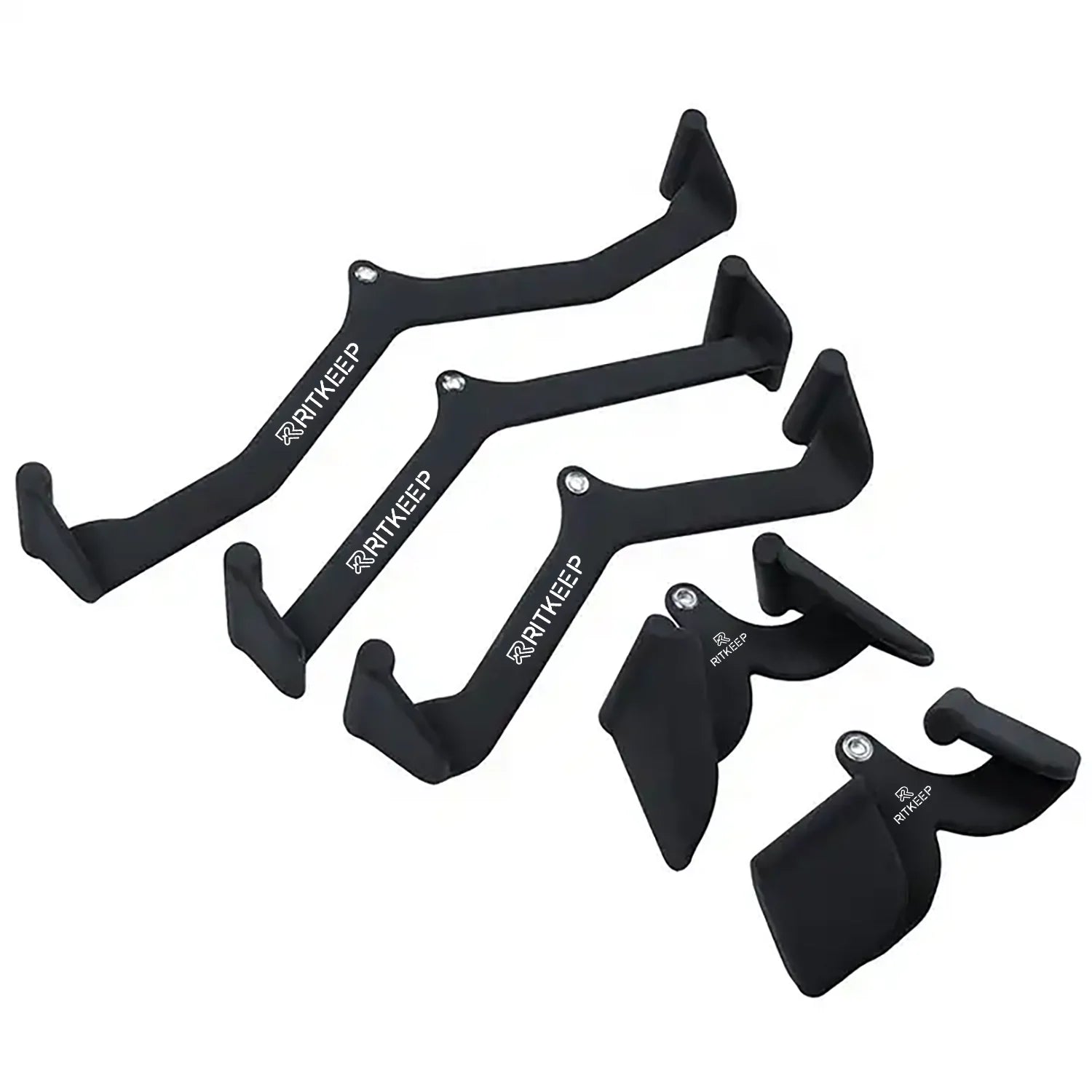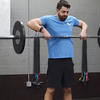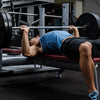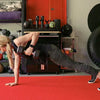The Ultimate Guide to the Barbell Upright Row: Proper Form, Muscles Worked, and Variations
Let's dive into one of the most effective—yet often debated—upper-body exercises: the upright row. Whether your goal is to build broader shoulders or boost your upper back strength, mastering the proper form of the barbell upright row is essential.
But before we break down the technique, you might be asking: What do upright rows work, exactly? Let’s take a closer look.
What Muscles Do Upright Rows Work?
The barbell upright row is a compound movement, meaning it engages multiple muscle groups at once. So, when you ask, "upright row muscles worked", here’s the breakdown:
Primary Muscles:
- Deltoids (Shoulders), especially the medial head.
- Trapezius (Upper Traps).
Secondary Muscles:
- Biceps, forearms, and grip muscles.
How to Perform the Barbell Upright Row with Proper Form
A standard Olympic barbell is a great place to start. If a full-size bar feels too heavy, you can use lighter fixed-weight barbells or smaller plates. Another excellent choice is the RitKeep 7ft Olympic Barbell Powerlifting Bar, designed for heavy lifting and compound movements, offering a stable grip and support for upright rows.
- Starting Position: Stand with your feet shoulder-width apart. Grasp the bar with an overhand grip (palms facing you), hands placed slightly closer than shoulder-width apart. Let the bar rest against the front of your thighs. Keep your chest up, shoulders back, and core braced.
- The Pull: This is the most critical part. Exhale and lead with your elbows—imagine pointing them toward the ceiling. Pull the bar vertically up the front of your body, keeping it as close to you as possible. The movement should be controlled and deliberate.
- Top Position: Continue pulling until the bar reaches chest level or your elbows are just above your shoulders. Avoid pulling the bar too high, as this increases stress on the shoulder joint. Squeeze your shoulder and trap muscles hard at the top.
- The Descent: Inhale and slowly lower the bar back to the starting position along the same path. Resist the temptation to let it drop quickly.
Common Training Mistakes
1. Grip Too Narrow
This is a very common issue. Holding the bar too close forces the shoulders into excessive internal rotation, which can increase the risk of impingement. A safer and more effective option is to keep your hands around one and a half times shoulder width. This provides the best mix of muscle activation and joint comfort. If a straight bar feels awkward or causes pain, it’s better to switch to an EZ bar. Always pay attention to how your shoulders feel any sharp or pinching pain is a sign to stop immediately.
2. Overextending the Range of Motion
Plenty of lifters think pulling the bar higher gives better results, but going above collarbone level only adds unnecessary stress to the shoulder joints. A smarter approach is to finish the pull when your elbows are in line with your shoulders, with the bar stopping around the upper chest. Using a mirror or asking a mate to check your form can help. Remember good quality reps are always better than forcing extra range.
3. Using Momentum
Relying on momentum is one of the main reasons people stop making progress. If your knees are bouncing or your torso is swinging back and forth, you’re not really targeting the right muscles and you’re more likely to get injured. To fix this, drop the weight, try using a tempo like 3 seconds up, 1-second pause, 3 seconds down, or even train with your back against a wall to keep things strict.
4. Poor Breathing Technique
Breathing properly makes a big difference. Exhale as you pull the bar up, inhale as you lower it back down, and avoid holding your breath. Keeping a steady breathing rhythm will help stabilise your core and keep your blood pressure under control, reducing injury risk.
Fundamental Issues with Upright Rows
1. Misconceptions and Risks of the Traditional Style
Looking back at old-school bodybuilding, the narrow-grip upright row—made popular by athletes like Arnold Schwarzenegger—was praised for the shoulder pump it gave. But what many didn’t realise is that this style also hides some serious risks for the shoulder joint. When you grip the bar around shoulder-width and pull it all the way up to ear level, your shoulders are forced into a position of both elevation and excessive internal rotation.
From an anatomical point of view, this combination squeezes the space under the acromion (the bony tip of your shoulder blade). Everyone has a small bony protrusion there, and when you lift this way, that protrusion presses down into the joint. Over time, this repeatedly compresses the soft tissues, including the rotator cuff tendons, the bursa, and even the long head of the biceps tendon.
2. The Risk of Long-Term Wear and Tear
It’s worth pointing out that upright rows don’t usually cause sudden injuries. Instead, the damage builds up slowly, like a rope that frays over time with constant rubbing. The soft tissues in your shoulders take the brunt of this ongoing stress. Even if you swap to an EZ bar, use lighter weights, or keep the range of motion shorter, the underlying biomechanical problem doesn’t completely go away. That’s why many lifters eventually look for safer variations or alternatives that target the same muscles without the long-term risks.
Modified Training Variations
1. Cable Upright Row
The cable upright row is an excellent variation that provides constant tension, making it safer for the shoulder joints compared to traditional upright rows. By using the cable machine, the tension on the muscles remains constant throughout the movement, and the adjustable angle reduces the strain on the shoulders. This variation is perfect for targeting the deltoids and upper traps while minimising joint stress.
Execution Points:
- Stand with your feet shoulder-width apart, using a straight bar or V-grip attachment.
- Lead with your elbows and pull the bar up to chest level.
- Keep the movement smooth and controlled, avoiding excessive swinging.
- Focus on muscle engagement at the top of the movement, pausing briefly.
2. EZ Bar Upright Row
The EZ bar upright row is a more joint-friendly alternative to the traditional barbell version. The curved design of the EZ bar reduces the internal rotation of the wrists and shoulders, helping to minimise the risk of strain. This is especially beneficial for those with shoulder discomfort. This variation allows for a more natural range of motion, making it an ideal choice for lifters who want to reduce joint stress while still targeting the shoulder and trapezius muscles effectively.
Execution Points:
- Grip the EZ bar with your hands slightly wider than shoulder-width.
- Focus on slow and controlled movement, and avoid jerking the bar up with momentum.
- Ensure your shoulders and wrists are comfortable throughout the movement.
3. Kettlebell Upright Row
The kettlebell upright row uses a neutral grip, which not only improves balance but also activates additional stabiliser muscles throughout the body. The offset centre of gravity of the kettlebell creates a unique challenge, making this variation a great option for those looking to improve functional strength while targeting the shoulders and upper traps.
Execution Points:
- Hold a kettlebell in each hand with your palms facing each other.
- Stand with your feet shoulder-width apart, keeping your core engaged.
- Pull the kettlebells upward along the front of your body, keeping them as close to you as possible.
- Maintain a steady pace and avoid using momentum or swinging the kettlebells.
Recommended Alternative Exercises
- Smith Machine Barbell Row – Controlled movement, great for stability and back strength.
- Dumbbell High Pull – Natural movement path.
- Strict Lateral Raise – Safest deltoid isolation.
- Face Pull – Improves shoulder health.
- Handstand Push-up – Advanced, builds stability and endurance.
The Bottom Line
When performed with proper form, the barbell upright row is powerful for the shoulders and traps. Safer variations like cable upright row, EZ bar upright row, kettlebell upright row, and alternatives like the smith machine barbell row make it adaptable for all lifters. Prioritise form, listen to your body, and enjoy the gains!
Best Home Gym Gear in RitKeep
These are our most popular home gym machines — combining Smith Machine and Power Rack in one. Perfect for both guided and free weight training to support your everyday fitness goals.
PMAX 5600 All-In-One Smith Machine - Integrated Weight System
✔️ 6 IN 1 Gym Station
✔️ With 75 KG Weight Stack On Each Side
✔️ Feel the Burn Through 80+ Exercises
PMAX 4750 Dual Plate Loaded Multi Functional Smith Machine
✔️ Fuel Your Workout with 100+ Exercises
✔️ Dual Independent Pulley System
✔️ Removable Jammer Arms & Leg Extension
Destroyer M10 ALL-IN-ONE Home Gym Power Rack With Pulley System
✔️ Crossover Cable Pulley System
✔️ Heavy-Duty Multi-Functional Rack
✔️ Offering over 80+ exercises













